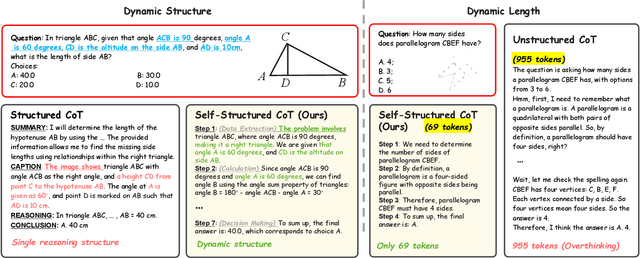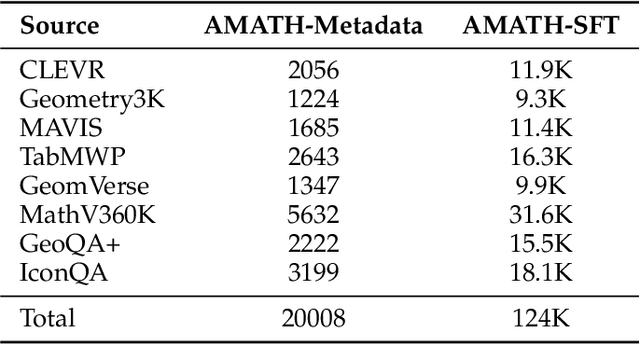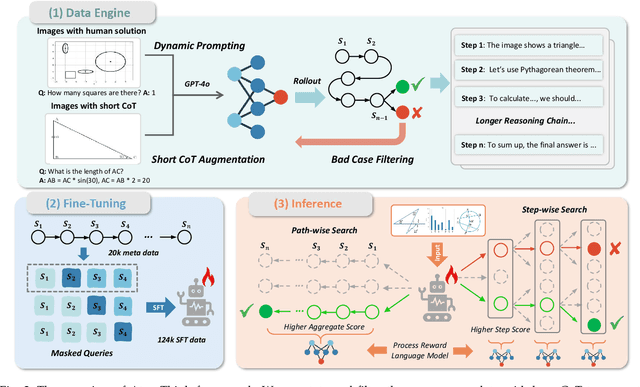Weiran Huang
Vision Matters: Simple Visual Perturbations Can Boost Multimodal Math Reasoning
Jun 11, 2025Abstract:Despite the rapid progress of multimodal large language models (MLLMs), they have largely overlooked the importance of visual processing. In a simple yet revealing experiment, we interestingly find that language-only models, when provided with image captions, can achieve comparable or even better performance than MLLMs that consume raw visual inputs. This suggests that current MLLMs may generate accurate visual descriptions but fail to effectively integrate them during reasoning. Motivated by this, we propose a simple visual perturbation framework that enhances perceptual robustness without requiring algorithmic modifications or additional training data. Our approach introduces three targeted perturbations: distractor concatenation, dominance-preserving mixup, and random rotation, that can be easily integrated into existing post-training pipelines including SFT, DPO, and GRPO. Through extensive experiments across multiple datasets, we demonstrate consistent improvements in mathematical reasoning performance, with gains comparable to those achieved through algorithmic changes. Additionally, we achieve competitive performance among open-source 7B RL-tuned models by training Qwen2.5-VL-7B with visual perturbation. Through comprehensive ablation studies, we analyze the effectiveness of different perturbation strategies, revealing that each perturbation type contributes uniquely to different aspects of visual reasoning. Our findings highlight the critical role of visual perturbation in multimodal mathematical reasoning: better reasoning begins with better seeing. Our code is available at https://github.com/YutingLi0606/Vision-Matters.
Advancing Multimodal Reasoning via Reinforcement Learning with Cold Start
May 28, 2025Abstract:Recent advancements in large language models (LLMs) have demonstrated impressive chain-of-thought reasoning capabilities, with reinforcement learning (RL) playing a crucial role in this progress. While "aha moment" patterns--where models exhibit self-correction through reflection--are often attributed to emergent properties from RL, we first demonstrate that these patterns exist in multimodal LLMs (MLLMs) prior to RL training but may not necessarily correlate with improved reasoning performance. Building on these insights, we present a comprehensive study on enhancing multimodal reasoning through a two-stage approach: (1) supervised fine-tuning (SFT) as a cold start with structured chain-of-thought reasoning patterns, followed by (2) reinforcement learning via GRPO to further refine these capabilities. Our extensive experiments show that this combined approach consistently outperforms both SFT-only and RL-only methods across challenging multimodal reasoning benchmarks. The resulting models achieve state-of-the-art performance among open-source MLLMs at both 3B and 7B scales, with our 7B model showing substantial improvements over base models (e.g., 66.3 %$\rightarrow$73.4 % on MathVista, 62.9 %$\rightarrow$70.4 % on We-Math) and our 3B model achieving performance competitive with several 7B models. Overall, this work provides practical guidance for building advanced multimodal reasoning models. Our code is available at https://github.com/waltonfuture/RL-with-Cold-Start.
Unsupervised Post-Training for Multi-Modal LLM Reasoning via GRPO
May 28, 2025Abstract:Improving Multi-modal Large Language Models (MLLMs) in the post-training stage typically relies on supervised fine-tuning (SFT) or reinforcement learning (RL). However, these supervised methods require expensive and manually annotated multi-modal data--an ultimately unsustainable resource. While recent efforts have explored unsupervised post-training, their methods are complex and difficult to iterate. In this work, we are the first to investigate the use of GRPO, a stable and scalable online RL algorithm, for enabling continual self-improvement without any external supervision. We propose MM-UPT, a simple yet effective framework for unsupervised post-training of MLLMs. MM-UPT builds upon GRPO, replacing traditional reward signals with a self-rewarding mechanism based on majority voting over multiple sampled responses. Our experiments demonstrate that MM-UPT significantly improves the reasoning ability of Qwen2.5-VL-7B (e.g., 66.3 %$\rightarrow$72.9 % on MathVista, 62.9 %$\rightarrow$68.7 % on We-Math), using standard dataset without ground truth labels. MM-UPT also outperforms prior unsupervised baselines and even approaches the results of supervised GRPO. Furthermore, we show that incorporating synthetic questions, generated solely by MLLM itself, can boost performance as well, highlighting a promising approach for scalable self-improvement. Overall, MM-UPT offers a new paradigm for continual, autonomous enhancement of MLLMs in the absence of external supervision. Our code is available at https://github.com/waltonfuture/MM-UPT.
Can Atomic Step Decomposition Enhance the Self-structured Reasoning of Multimodal Large Models?
Mar 08, 2025Abstract:In this paper, we address the challenging task of multimodal mathematical reasoning by incorporating the ability of "slow thinking" into multimodal large language models (MLLMs). Our core idea is that different levels of reasoning abilities can be combined dynamically to tackle questions with different complexity. To this end, we propose a paradigm of Self-structured Chain of Thought (SCoT), which is composed of minimal semantic atomic steps. Different from existing methods that rely on structured templates or free-form paradigms, our method can not only generate cognitive CoT structures for various complex tasks but also mitigates the phenomenon of overthinking. To introduce structured reasoning capabilities into visual understanding models, we further design a novel AtomThink framework with four key modules, including (i) a data engine to generate high-quality multimodal reasoning paths; (ii) a supervised fine-tuning process with serialized inference data; (iii) a policy-guided multi-turn inference method; and (iv) an atomic capability metric to evaluate the single step utilization rate. We conduct extensive experiments to show that the proposed AtomThink significantly improves the performance of baseline MLLMs, achieving more than 10\% average accuracy gains on MathVista and MathVerse. Compared to state-of-the-art structured CoT approaches, our method not only achieves higher accuracy but also improves data utilization by 5 times and boosts inference efficiency by 85.3\%. Our code is now public available in https://github.com/Quinn777/AtomThink.
Information-Theoretic Perspectives on Optimizers
Feb 28, 2025



Abstract:The interplay of optimizers and architectures in neural networks is complicated and hard to understand why some optimizers work better on some specific architectures. In this paper, we find that the traditionally used sharpness metric does not fully explain the intricate interplay and introduces information-theoretic metrics called entropy gap to better help analyze. It is found that both sharpness and entropy gap affect the performance, including the optimization dynamic and generalization. We further use information-theoretic tools to understand a recently proposed optimizer called Lion and find ways to improve it.
AtomThink: A Slow Thinking Framework for Multimodal Mathematical Reasoning
Nov 18, 2024



Abstract:In this paper, we address the challenging task of multimodal mathematical reasoning by incorporating the ability of ``slow thinking" into multimodal large language models (MLLMs). Contrary to existing methods that rely on direct or fast thinking, our key idea is to construct long chains of thought (CoT) consisting of atomic actions in a step-by-step manner, guiding MLLMs to perform complex reasoning. To this end, we design a novel AtomThink framework composed of three key modules: (i) a CoT annotation engine that automatically generates high-quality CoT annotations to address the lack of high-quality visual mathematical data; (ii) an atomic step fine-tuning strategy that jointly optimizes an MLLM and a policy reward model (PRM) for step-wise reasoning; and (iii) four different search strategies that can be applied with the PRM to complete reasoning. Additionally, we propose AtomMATH, a large-scale multimodal dataset of long CoTs, and an atomic capability evaluation metric for mathematical tasks. Extensive experimental results show that the proposed AtomThink significantly improves the performance of baseline MLLMs, achieving approximately 50\% relative accuracy gains on MathVista and 120\% on MathVerse. To support the advancement of multimodal slow-thinking models, we will make our code and dataset publicly available on https://github.com/Quinn777/AtomThink.
SAFE: Slow and Fast Parameter-Efficient Tuning for Continual Learning with Pre-Trained Models
Nov 04, 2024



Abstract:Continual learning aims to incrementally acquire new concepts in data streams while resisting forgetting previous knowledge. With the rise of powerful pre-trained models (PTMs), there is a growing interest in training incremental learning systems using these foundation models, rather than learning from scratch. Existing works often view PTMs as a strong initial point and directly apply parameter-efficient tuning (PET) in the first session for adapting to downstream tasks. In the following sessions, most methods freeze model parameters for tackling forgetting issues. However, applying PET directly to downstream data cannot fully explore the inherent knowledge in PTMs. Additionally, freezing the parameters in incremental sessions hinders models' plasticity to novel concepts not covered in the first session. To solve the above issues, we propose a Slow And Fast parameter-Efficient tuning (SAFE) framework. In particular, to inherit general knowledge from foundation models, we include a transfer loss function by measuring the correlation between the PTM and the PET-applied model. After calibrating in the first session, the slow efficient tuning parameters can capture more informative features, improving generalization to incoming classes. Moreover, to further incorporate novel concepts, we strike a balance between stability and plasticity by fixing slow efficient tuning parameters and continuously updating the fast ones. Specifically, a cross-classification loss with feature alignment is proposed to circumvent catastrophic forgetting. During inference, we introduce an entropy-based aggregation strategy to dynamically utilize the complementarity in the slow and fast learners. Extensive experiments on seven benchmark datasets verify the effectiveness of our method by significantly surpassing the state-of-the-art.
CrystalX: Ultra-Precision Crystal Structure Resolution and Error Correction Using Deep Learning
Oct 17, 2024Abstract:Atomic structure analysis of crystalline materials is a paramount endeavor in both chemical and material sciences. This sophisticated technique necessitates not only a solid foundation in crystallography but also a profound comprehension of the intricacies of the accompanying software, posing a significant challenge in meeting the rigorous daily demands. For the first time, we confront this challenge head-on by harnessing the power of deep learning for ultra-precise structural analysis at the full-atom level. To validate the performance of the model, named CrystalX, we employed a vast dataset comprising over 50,000 X-ray diffraction measurements derived from authentic experiments, demonstrating performance that is commensurate with human experts and adept at deciphering intricate geometric patterns. Remarkably, CrystalX revealed that even peer-reviewed publications can harbor errors that are stealthy to human scrutiny, yet CrystalX adeptly rectifies them. This deep learning model revolutionizes the time frame for crystal structure analysis, slashing it down to seconds. It has already been successfully applied in the structure analysis of newly discovered compounds in the latest research without human intervention. Overall, CrystalX marks the beginning of a new era in automating routine structural analysis within self-driving laboratories.
ATLAS: Adapter-Based Multi-Modal Continual Learning with a Two-Stage Learning Strategy
Oct 14, 2024



Abstract:While vision-and-language models significantly advance in many fields, the challenge of continual learning is unsolved. Parameter-efficient modules like adapters and prompts present a promising way to alleviate catastrophic forgetting. However, existing works usually learn individual adapters for each task, which may result in redundant knowledge among adapters. Moreover, they continue to use the original pre-trained model to initialize the downstream model, leading to negligible changes in the model's generalization compared to the original model. In addition, there is still a lack of research investigating the consequences of integrating a multi-modal model into the updating procedure for both uni-modal and multi-modal tasks and the subsequent impacts it has on downstream tasks. In this paper, we propose an adapter-based two-stage learning paradigm, a multi-modal continual learning scheme that consists of experience-based learning and novel knowledge expansion, which helps the model fully use experience knowledge and compensate for novel knowledge. Extensive experiments demonstrate that our method is proficient for continual learning. It expands the distribution of representation upstream while also minimizing the negative impact of forgetting previous tasks. Additionally, it enhances the generalization capability for downstream tasks. Furthermore, we incorporate both multi-modal and uni-modal tasks into upstream continual learning. We observe that learning from upstream tasks can help with downstream tasks. Our code will be available at: https://github.com/lihong2303/ATLAS.
Investigating the Impact of Model Complexity in Large Language Models
Oct 01, 2024Abstract:Large Language Models (LLMs) based on the pre-trained fine-tuning paradigm have become pivotal in solving natural language processing tasks, consistently achieving state-of-the-art performance. Nevertheless, the theoretical understanding of how model complexity influences fine-tuning performance remains challenging and has not been well explored yet. In this paper, we focus on autoregressive LLMs and propose to employ Hidden Markov Models (HMMs) to model them. Based on the HMM modeling, we investigate the relationship between model complexity and the generalization capability in downstream tasks. Specifically, we consider a popular tuning paradigm for downstream tasks, head tuning, where all pre-trained parameters are frozen and only individual heads are trained atop pre-trained LLMs. Our theoretical analysis reveals that the risk initially increases and then decreases with rising model complexity, showcasing a "double descent" phenomenon. In this case, the initial "descent" is degenerate, signifying that the "sweet spot" where bias and variance are balanced occurs when the model size is zero. Obtaining the presented in this study conclusion confronts several challenges, primarily revolving around effectively modeling autoregressive LLMs and downstream tasks, as well as conducting a comprehensive risk analysis for multivariate regression. Our research is substantiated by experiments conducted on data generated from HMMs, which provided empirical support and alignment with our theoretical insights.
 Add to Chrome
Add to Chrome Add to Firefox
Add to Firefox Add to Edge
Add to Edge